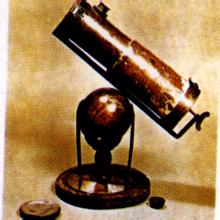Quite what Halley expected to get from him when he made his unannounced visit in August 1684 we can only guess. But thanks to the later account of a Newton confidant, Abraham DeMoivre, we do have a record of one of science's most historic encounters:
1684年8月,哈雷不請自來,登門拜訪牛頓。他指望從牛頓那里得到什么幫助,我們只能猜測。但是,多虧一位牛頓的密友--亞伯拉罕•棣莫佛后來寫的一篇敘述,我們才有了一篇有關科學界一次最有歷史意義的會見的記錄:
In 1684 Dr Halley came to visit at Cambridge (and) after they had some time together the Drasked him what he thought the curve would be that would be described by the Planets supposing the force of attraction toward the Sun to be reciprocal to the square of their distance from it.
1684年,哈雷博士來劍橋拜訪。他們在一起待了一會兒以后,博士問他,要是太陽的引力與行星離太陽距離的平方成反比,他認為行星運行的曲線會是什么樣的。

This was a reference to a piece of mathematics known as the inverse square law, which Halley was convinced lay at the heart of the explanation, though he wasn't sure exactly how.
這里提到的是一個數學問題,名叫平方反比律。哈雷堅信,這是解釋問題的關鍵,雖然他對其中的奧妙沒有把握。
Sr Isaac replied immediately that it would be an (ellipse). The Doctor, struck with joy and amazement, asked him how he knew it. 'Why,' saith he, 'I have calculated it,' whereupon DrHalley asked him for his calculation without farther delay, SrIsaac looked among his papers but could not find it.
艾薩克•牛頓馬上回答說,會是一個橢圓。博士又高興又驚訝,問他是怎么知道的。"哎呀,"他說,"我已經計算過。"接著,哈雷博士馬上要他的計算材料。艾薩克爵士在材料堆里翻了一會兒,但是找不著。
This was astounding—like someone saying he had found a cure for cancer but couldn't remember where he had put the formula. Pressed by Halley, Newton agreed to redo the calculations and produce a paper. He did as promised, but then did much more. He retired for two years of intensive reflection and scribbling, and at length produced his masterwork: the Philosophiae Naturalis Principia Mathematica or Mathematical Principles of Natural Philosophy, better known as the Principia .
這是很令人吃驚的--猶如有人說他已經找到了治愈癌癥的方法,但又記不清處方放在哪里了。在哈雷的敦促之下,牛頓答應再算一遍,便拿出了一張紙。他按諾言做了,但做得要多得多。有兩年時間,他閉門不出,精心思,最后他終于成就了一部杰作,自然哲學的數學原理和自然哲學的數學原理,人們習慣稱呼它為更好地稱為原理。











